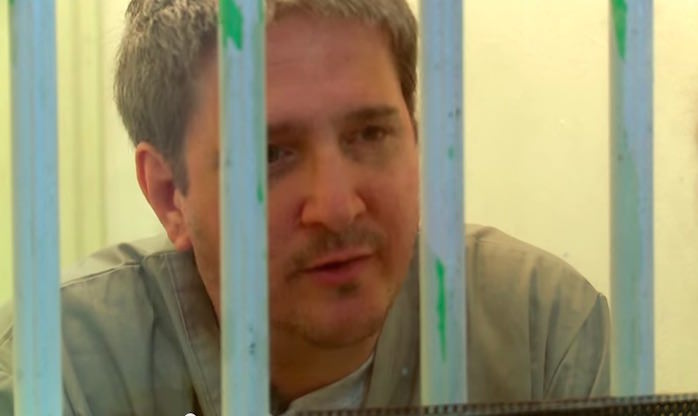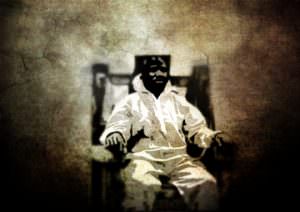An Oklahoma Man Awaits a ‘Cruel and Unusual’ Execution
The U.S. Supreme Court has ruled that Richard Glossip can be executed in September, despite the strong evidence of his innocence and the intense pain that Oklahoma's injection cocktail is known to cause. Richard Glossip in a 2015 interview. (Micah Leon / YouTube)
Richard Glossip in a 2015 interview. (Micah Leon / YouTube)
Time is running out for Richard Glossip.
In June, the United States Supreme Court rejected his appeal challenging the constitutionality of lethal injection in a heartbreaking 5-4 decision. Now, he’s scheduled to die in Oklahoma’s death chamber Sept. 16.
In any other year, the court’s ruling in Glossip’s case might have garnered a profusion of media attention. But coming on the heels of the court’s landmark decisions on same-sex marriage and Obamacare, it has been all but forgotten in the 24-hour news cycle, save for an excellent article in The Intercept this month.
That’s a pity — not just for Glossip, but for all of us. His case is the kind that should keep people of good conscience awake at night. Both morally and legally, it illustrates many of the most troubling flaws in our system of state-sanctioned killing: the risk of executing the innocent, the inadequate legal representation often provided to poor criminal defendants charged with the most serious offenses, the inconsistencies of the appeal process, and the cruelty of all forms of capital punishment.
Glossip, 51, was arrested in January 1997 and charged with first-degree murder for the death of Barry Van Treese, the owner of the Best Budget Inn, a down-market motel frequented by drunks, prostitutes, drug dealers and others on the west side of Oklahoma City. Van Treese’s body was discovered on the evening of Jan. 7 in Room 102. He had been bludgeoned.
Glossip had worked for Van Treese as an on-site manager. In that job, he had earned $1,500 per month, and he had needed every penny of his earnings. According to local prosecutors, Glossip feared being fired, or worse, for skimming money from the inn’s receipts. He needed an out, and quickly, because Van Treese had begun to audit the inn’s financial records.
But there was a problem for the prosecution in its quest to hold Glossip responsible for Van Treese’s demise: Glossip did not personally kill Van Treese, and there was no physical evidence connecting him to the incident in Room 102. Unable to show that Glossip had committed the homicide himself, the prosecution constructed an alternative scenario in which Glossip convinced Justin Sneed — a meth-addicted 19-year-old roofer who lived at the motel in exchange for maintenance work — to commit the crime for him by promising Sneed money and additional jobs.
Sneed was apprehended a week after Van Treese was slain. After he was taken to police headquarters, he was interrogated and was offered a deal that would spare him the death penalty if he confessed. He admitted to beating Van Treese with a baseball bat, but he fingered Glossip as the architect of a jointly made plan. Subsequent searches revealed that Sneed had possessed $1,700 in cash at the time of his arrest and that Glossip had had $1,200.
Although Glossip claimed his money had come from paychecks and the sale of personal items and that he had intended to use it to buy breast implants as a birthday present for his girlfriend, the police demurred. Certain that they had confirmed their theory — murder for hire — the authorities formally charged Glossip.
Since the death penalty’s reinstatement by the Supreme Court in 1976, it has been limited to murder prosecutions. But a defendant need not be a hands-on killer in order to be eligible for capital punishment in many jurisdictions, including in Oklahoma. According to the Death Penalty Information Center, at least 10 people have been put to death for contract slayings since the modern era of capital punishment began.
At Glossip’s first trial, in June 1998, Sneed was the state’s star witness, and based largely on Sneed’s testimony Glossip’s jury determined not only that he was behind the murder but that the state had proved two aggravating circumstances warranting a death sentence — that the murder was especially heinous and cruel and that Glossip posed a “continuing threat to society,” even though the only alternative sentence for him was life in prison without the possibility of parole. Prior to his conviction, Glossip had had no criminal record.
The weakness of the prosecution’s case, built on the self-serving statements of an admitted killer, became apparent in due course to the Oklahoma Court of Criminal Appeals. In 2001, that court unanimously reversed Glossip’s conviction without even holding oral argument, ruling that the performance of Glossip’s trial counsel was so deficient that “we have no confidence that a reliable adversarial proceeding took place.”
In that court’s view, Glossip’s attorney had also failed to introduce an available videotape of Sneed’s confession, which could have made a crucial difference in Glossip’s defense team’s ability to cross-examine Sneed. The court emphasized that the evidence against Glossip “was circumstantial except for the testimony of Justin Sneed.”Undeterred by such blunt commentary, the state retried Glossip, who by then was represented by a new team of lawyers, and it secured a second conviction and death sentence, in August 2004. Three years later, in a closely divided 3-2 decision, the Oklahoma Court of Criminal Appeals affirmed both the conviction and the sentence.
Glossip’s lawyers then spent the next seven years filing additional writs and appeals without success and without attracting much national attention, until April 29, 2014, when the Oklahoma Department of Corrections horrendously botched the lethal injection of Clayton Lockett, a 38-year-old African-American. After receiving a three-drug cocktail that — for the first time in the state’s history — began with an injection of the sedative midazolam, Lockett agonized for a reported 43 minutes before he succumbed. The state had shifted from pentobarbital to midazolam because the former had become increasingly harder to obtain.
Glossip’s attorneys — together with lawyers for three other condemned Oklahoma prisoners, including one Charles Warner — responded promptly to Lockett’s gruesome death by filing a federal lawsuit seeking to enjoin the state’s use of the new three-drug mixture and arguing that it violated the Eighth Amendment’s prohibition of “cruel and unusual punishment.” A brief stay was issued, putting the state’s executions on hold, but the moratorium was lifted by the 10th Circuit Court of Appeals on Jan. 12.
Three days later, the U.S. Supreme Court declined to consider further stay requests from any of the inmates. Within a matter of hours, Warner was on a gurney with a midazolam-laced chemical combination coursing through his veins. As he lay dying, Warner complained that the drugs in his body felt “like acid.”
Then in an extraordinary turn of events that laid bare the arbitrary and capricious nature of the death penalty even at the highest level of the judiciary, the Supreme Court reversed course Jan. 28 and ordered stays of execution for Glossip and his two remaining co-plaintiffs. The litigation was retitled, with Glossip replacing the deceased Warner as the lead party, and oral argument was scheduled for April 29.
Although the technical issue before the justices was narrowly framed — whether Oklahoma’s use of midazolam in its lethal injection protocol violated the Eighth Amendment — the court’s June 29 decision approving the protocol has broad ramifications for the future of capital punishment.
Justice Samuel Alito’s majority opinion, endorsed by the court’s other Republican appointees, is an exercise in circular reasoning that has established a new set of “Wonderland rules for method-of-execution claims,” according to Steven Schwinn, a professor at the John Marshall School of Law in Chicago.
“Because capital punishment is legal,” Alito wrote, “there must be a constitutional means of carrying it out.” Surveying the history of the death penalty, he continued: While methods of execution (from hanging to electrocution, firing squads, lethal gas and injections) have changed over the years, the Supreme Court “has never invalidated a State’s chosen procedure.”
Nor were Alito and his conservative colleagues about to do so in this term, even though record clearly shows that midazolam is ineffective and leads to extreme pain during executions. Worse still, Alito assigned the burden of proof in such death penalty cases to the inmates seeking to stay alive rather than to the states seeking to kill them. That burden, he elaborated, is twofold, requiring prisoners to show both that any challenged means of execution “presents a risk that is sure or very likely to cause needless suffering” and that there are “feasible, readily implemented” and less painful alternatives available to the states for putting them to death. Glossip and his fellow petitioners, Alito held, failed both prongs.
Not content with Alito’s grim majority decision, Justice Antonin Scalia crafted a particularly venomous and unhinged concurrence that began with the salutation: “Welcome to Groundhog Day.” From Scalia’s twisted perspective, condemned prisoners like Glossip have no business taking up the court’s precious time with doomed objections to being executed. In addition, he charged that the opinions of the dissenting justices were exemplars of inferior scholarship, especially the one authored by Justice Steven Breyer, which he called “gobbledy-gook.”
What offended Scalia most deeply about Breyer’s dissenting opinion — which was joined by Justice Ruth Bader Ginsburg — was that Breyer had the temerity to suggest that the nation’s experiment with creating a rational, reliable and fair system of capital punishment had failed and that the time had come to re-evaluate the entire system’s constitutionality. Breyer’s opinion marked the first time since the late Justice Harry Blackman’s 1994 dissent in a case from Texas that a sitting member of the court had formally taken an abolitionist position on the issue.
Unfortunately, Breyer’s fine sentiments offer little comfort to the condemned.
Glossip and his supporters, whose ranks include the renowned death penalty opponent Sister Helen Prejean, insist that he had nothing to do with Van Treese’s murder.
His defense attorneys are frantically working to present new evidence of his innocence. Late last year, they obtained a letter from Sneed’s adult daughter, who wrote that her father has told her he wants to recant his testimony against Glossip. However, Sneed, who is serving a life sentence, has yet to issue a statement of his own.
But even if Sneed finds the courage to come forward, there is no assurance that the courts will accept his recantation. In the modern era of capital punishment, 10 men have been executed despite strong evidence of their innocence. Their case histories are chronicled on the Death Penalty Information Center’s website. Come September, Richard Glossip could raise the number to 11.
Your support matters…Independent journalism is under threat and overshadowed by heavily funded mainstream media.
You can help level the playing field. Become a member.
Your tax-deductible contribution keeps us digging beneath the headlines to give you thought-provoking, investigative reporting and analysis that unearths what's really happening- without compromise.
Give today to support our courageous, independent journalists.





You need to be a supporter to comment.
There are currently no responses to this article.
Be the first to respond.